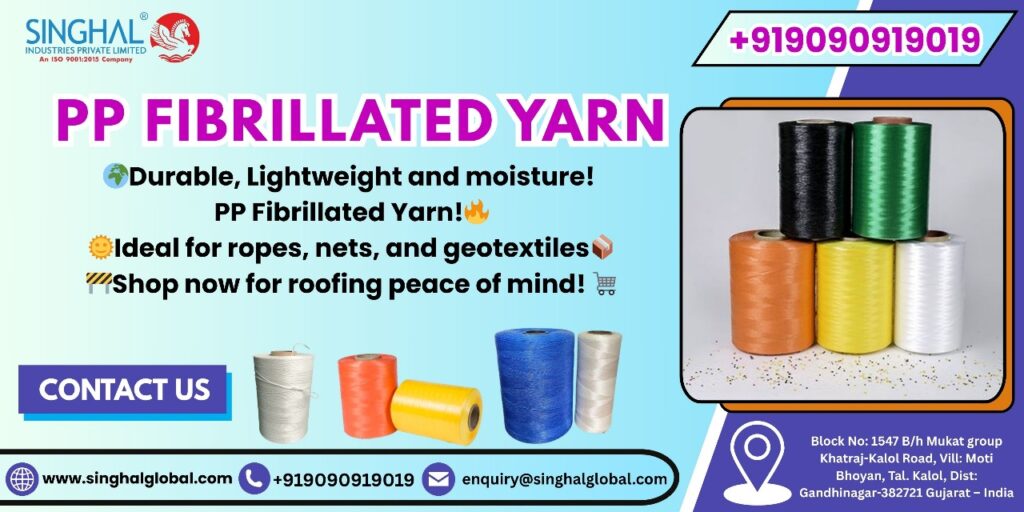Reliability does not go hand in hand with the world of construction, mainly road building. Roads also experience wear and tear day in and day out. There is no end to the challenges: big trucks and unforeseeable weather! It is for this reason that the construction industry is always in a rush to find materials that can be stronger, smarter, and last longer. PP fibrillated yarn is one of those silent stars that are revolutionizing the road infrastructure in the world.
You may now be thinking, how can yarn, which is as soft as silky fibre, be used to make something as hard as roads? That is the beauty of modern engineering. One might think that it is just a plain white piece of synthetic fiber, but it is a true powerhouse. And in nations such as India, where there is a high level of infrastructure development and also a change in climate, demand for Fibrillated yarn India is consistently increasing.
It is time to take a closer look at how polypropylene filament yarn is becoming a silent superhero in road construction and why polypropylene yarn manufacturers are at the forefront of green and cost-efficient engineering.
What Is PP Fibrillated Yarn Anyway?
PP is an acronym for Polypropylene filament yarn, a type of thermoplastic polymer commonly used in several industries because it is light, highly chemical-resistant, and durable.
Fibrillated yarn is a special kind of polypropylene fibre that is slit and stretched to make a net-like or mesh structure. This network webbed or mesh provides improved bonding with such materials as bitumen and concrete. It is not an average sewing yarn; it is industrial grade.
The fibrillated yarn’s special characteristic is that it can open up in the asphalt or concrete layer, creating a three-dimensional structure. This improves the mix’s mechanical performance, and as such, roads will be stronger and less prone to cracks.
Why Is It Used in Road Construction?
Roads crack. It is a fact. Water, ground shifting, or just a simple aging case, damage can be seen on almost every road. PP fibrillated yarn assists in remedying it.
Here’s how:
- Reinforcement: The yarn is mesh-like, and it can hold the road material well together, increasing tensile strength.
- Crack Resistance: It inhibits the further growth of microcracks and behaves as a mini reinforcement bar in each inch of road.
- Service: PP yarn is waterproof, resistant to UV, and can not be easily worn out, making it ideal for use on an Indian highway.
- Flexibility: Flexibility benefits roads in areas prone to earthquakes or floods.
Roads in Maharashtra’s Rural Belt
We will take a real example. The local panchayats in rural Maharashtra have used PP fibrillated yarn as part of the process of reconstruction of village link roads destroyed in monsoon floods.
Conventional patchwork repairs are something that would only last 6-8 months. However, when they included fibrillated yarn in the base and sub-base layers, the impact of the monsoons was reduced to two cycles with minimal loss of the roads. Villagers could observe fewer potholes, improved control of vehicles, and even a connection to the farm produce.
One of the hometown contractors commented, We thought it was just another gimmick. However, after two years and the result is concrete, literally.”
Why Polypropylene Is a Game-Changer
Polypropylene is a material with a high strength-to-weight ratio. This is important when your job is road building because you are trying to get strength but not weight.
India is the top Polypropylene yarn manufacturers country where engineering fibrillated yarns, which are of international standard, high in tenacity, low in water absorption, and their resistance to acidic, alkaline, and UV rays stands tall.
Moreover, polypropylene is collected. So, you are not only constructing superior roads—you are doing it in a sustainable way.
Not Just for Roads: Agricultural and Other Uses
Although in this case it is all about road construction, PP fibrillated yarn can be used in numerous ways:
- Soil stabilization
- Geotextile manufacturing
- Greenhouse shading
- Turf reinforcement
- Netting crop protection
Innovation That Makes Sense
To be truthful, when I think of the word yarn, I think of sweaters, not highways. However, the deeper I delved into real-world applications, the more logic behind it there became.
This is not the matter of adding something decorative to roads. It is the question of combining science and practicality. Minor changes offer a significant effect.
When a single piece of yarn can give life to a road in a village or save maintenance expenses of a state highway, what is not to make use of it?
Conclusion
The national scale of infrastructural development, such as roads, is unlike anything seen in India before. Highways, rural roads, and smart city infrastructure are being built. However, it is not enough to build fast. We have to develop smartness and sustainability. PP fibrillated yarn is ideal for such a philosophy.
This is why, regardless of whether you are a government contractor, a civil engineer, or even a policymaker, it is high time to look beyond the concrete and asphalt. Now, it is time to think about smaller details that could make an enormous impact, as the system of yarn would do.
Let us develop durable, resistant roads—roads that know each footstep, each wheel, and every monsoon and are still firm.
Frequently Asked Questions (FAQs)
Q1. How can PP fibrillated yarn be principally used?
The uses of PP fibrillated yarn are in construction of roads, geotextile, horticulture, agriculture, erosion protection, turf reinforcement. Its mesh construction enhances strength and durability in soft and hard applications.
Q2. How strong is PP fibrillated yarn?
It is strong in its tensile strength, has superior elongation, and is chemical, UV, and moisture resistant—an ideal material that would otherwise be susceptible to wearing out over an extended period of exposure in the outdoor scenario.
Q3. Is it suitable for agricultural applications?
Yes! Farmers use it to protect crops using protection nets or crop nets, shade greenhouses, and even reinforce the soil. It is resistant to water and durable enough to be used in wet or dry farming conditions.
Q4. Is it used in construction projects?
Absolutely. In addition to roads, it is also applied during reinforcement of foundations, retaining walls, erosion control structures, and so forth. It is low-maintenance and high-performance in nature, hence its value to construction professionals.









